~ Latin Mass ~

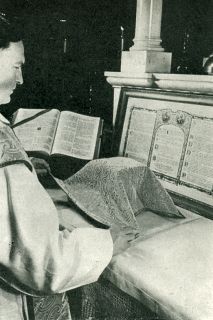
The Offertory

The Offertory
This is the first principal part of the Holy Mass. The best gift we can offer God is a pure heart, humble and sorrowful for having offended Him by our sins. Offer your heart when the priest offers the oblation of this Sacrifice.
“I consecrate to Thee, O Lord, every thought, every word and deed of my whole life. I give Thee my understanding, my will and memory.”
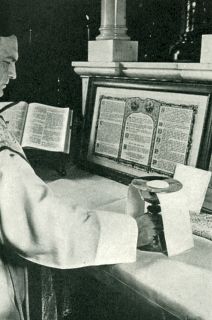
The Chalice Is Placed to the Right of the Corporal
The Chalice Is Placed to the Right of the Corporal
After the celebrant has unveiled the Chalice and placed the Pal, that is the little white card which you observe, directly in back of the Chalice against the altar card, he prepares himself for offering the Host. The Host, the small white particle of unleavened bread, can be observed on the Paten. At the Last Supper, as we noted before, Our Lord took unleavened bread and offered it to His Heavenly Father.
“We offer Thee, Almighty and Eternal God, this pure Host, for our innumerable sins, for all here present, and for all the Faithful, living and dead. May it help us and them to life everlasting.”
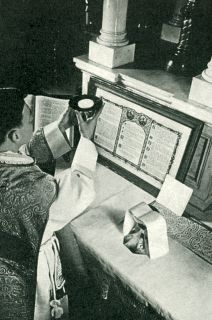
Offertory of the Host
Offertory of the Host
We recall from our study of the Last Supper that our Lord Jesus Christ took the unleavened bread which was to be consumed with the Paschal Lamb into His hands and offered it to His Heavenly Father. The unleavened bread of Divine Sacrifice, the Host, later in the Holy Mass becomes the Body and Blood of our Savior, Jesus Christ. When the priest prays at the Offertory, think how Pilate showed Christ to the people all covered with sweat and blood, saying to them,
“Ecce Homo!” (“Behold the Man!”)
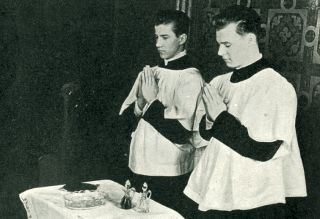
The Servers Assist the Priest with Water and Wine
The Servers Assist the Priest with Water and Wine
After the cymbal or the little bell has been rung the server or servers go to the middle of the altar, genuflect and proceed to the credence table. On this table is found the wine and the water in the little cruets. You observe to the right, the Towel, which the priest uses to wipe his fingers after they were cleansed with water and the little receptacle for receiving the drops of water during the ablution. Directly in back of the little bowl can be seen the gold Paten-like or dish-like tray which is used during the Communion time as a protection against desecration of the consecrated species if they should fall during the distribution of Holy Communion.
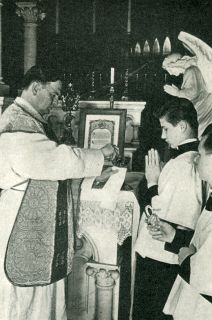
The Priest Receives the Wine
The Priest Receives the Wine
After purifying the Chalice the priest proceeds to the right hand side of the altar (the Epistle side). Here he receives the cruet containing the wine. The Purificator is held near the node or the little knob on the Chalice as a protection against the drops of wine falling on the altar linens. He then receives the water saying the following prayer:
“O God who so wonderfully didst give dignity to human nature, and didst more wonderfully restore it, grant through the mysteries of this water and wine we may partake of His Divinity Who partook of our humanity, Jesus Christ, Thy Son, our Lord Who liveth and reigneth with Thee in unity with the Holy Ghost world without end. Amen.”
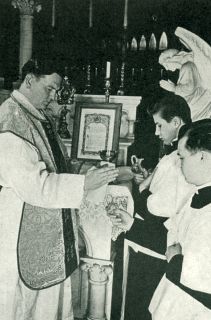
Blessing of the Water
Blessing of the Water
After having placed the Host upon the Corporal the priest takes the Chalice, purifies it with the linen cloth called the Purificator and proceeds to the right side of the altar where the server or servers supply him with the wine and water. After pouring the wine into the Chalice, the priest with a blessing adds a few drops of water. (The blessing of water is omitted in Masses for the Dead.)
When the wine and water are mingled, they can never be separated. This is to remind us to pray that we may never be separated from our Lord Jesus Christ. The celebrant prays that by the mingling of water and wine we may become partakers of Christ’s Divinity.
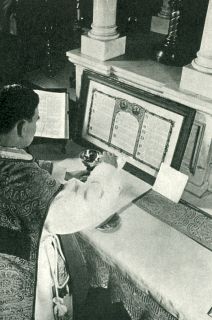
The Priest Returns Again to the Center of the Altar
The Priest Returns Again to the Center of the Altar
After receiving the water and wine, the priest returns to the center of the altar where he offers the wine as a part of the Sacrifice. Before the Offertory of the wine, however, he must be assured that the mixing of the wine and the water is complete and that the Chalice contains nothing but the mixture of water and wine. For that reason he uses the Purificator and removes any unmixed water or wine from within the cup of the Chalice.
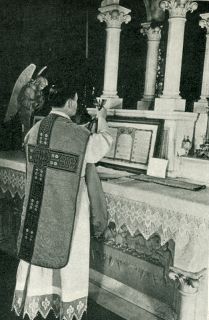
Offering of the Chalice
Offering of the Chalice
Returning to the center of the altar, the priest holds up the Chalice, offering it to our Lord.
“We offer Thee, O Lord, the Chalice of Salvation. With it we offer our bodies, our souls, and all; whatever we are and have. May it become a pleasing sacrifice before Thee. Receive it Father, graciously.”
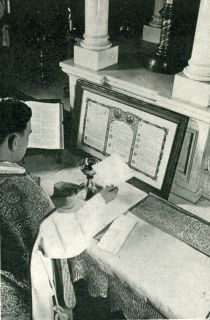
The Priest Places the Pall on the Chalice
The Priest Places the Pall on the Chalice
After the Offertory, the priest places the Chalice after forming the sign of the cross with it over the Corporal proper. Here it rests until the time of Consecration. The pall, as we noted before, is the square linen card used to cover the Chalice as a protection against any particles of extraneous matter falling into it. He then blesses both the wine and the water saying:
“Come, Omnipotent Sanctifier, Eternal God; and bless this Sacrifice prepared in Thy Holy Name.”
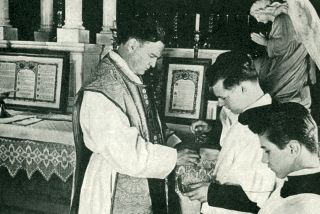
The Priest Purifies His Hands (Lavabo)
The Priest Purifies His Hands (Lavabo)
In reverence and respect for our Lord in the Blessed Sacrament after the Consecration, the priest again goes to the Epistle side of the altar and cleanses his fingers. During this ceremony, say the following prayer:
“I will wash my hands among the innocent and I will compass Thy altar, O Lord; that I may hear the voice of praise and tell of Thy wondrous works. O Lord, I have loved the beauty of Thy house, and the place where Thy glory dwelleth."
The washing of hands signifies purity and should encourage us to not only cleanse our bodies but our souls when we approach the great Sacrifice of God's Love.
Continue with the...
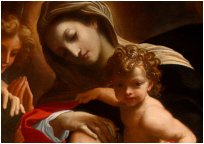
© StGemma.com Web Productions Inc. 2005-PRESENT. All rights reserved.
|

Home
Preparation
Offertory
Canon
Communion
Conclusion
Appendix I
(Altar & Sanctuary Guide)
Appendix II
(Server Instructions)
Appendix III
(Pronunciation of Latin)
Appendix IV
(Pius V Quo Primum)
Catholic News
Rosary in Latin
Gregory XVII "Siri"
The Pope in Red
The 7 Prayers of Fatima
Rare Gregorian Chant
The Coming Great Catholic Monarch St. John Bosco's Dream (Vision) of Hell
Michael Dimond:
a False Prophet
Original St. Michael Prayer (Exorcism)
Examination of Conscience
Antichrist
(Catholic Prophecy)
Catholic Prayer
Infant Baptism in Emergency
Catholic Podcasts
Catholic Links
Email-Where to Receive Traditional Sacraments
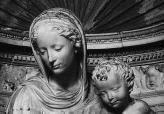
|














